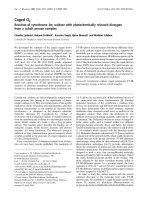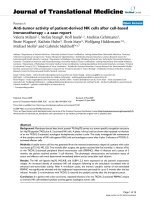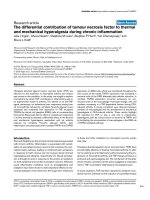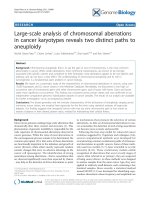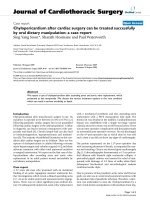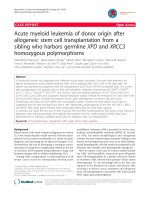Báo cáo y học: "Rare ileal localisation of angiolipoma presenting as chronic haemorrhage and severe anaemia: a case report" ppsx
Bạn đang xem bản rút gọn của tài liệu. Xem và tải ngay bản đầy đủ của tài liệu tại đây (409.64 KB, 4 trang )
BioMed Central
Page 1 of 4
(page number not for citation purposes)
Journal of Medical Case Reports
Open Access
Case report
Rare ileal localisation of angiolipoma presenting as chronic
haemorrhage and severe anaemia: a case report
Nicola Della Volpe
†
, Luigi Bianco
†
, Claudio Bonuso*, Mario Annecchiarico
†
,
Pierino Di Silverio
†
and Assunta Caiazza
†
Address: Department of General and Geriatric Surgery, Diagnostic and Operative Endoscopy, School of Medicine, University of Naples 'Federico
II', Italy
Email: Nicola Della Volpe - ; Luigi Bianco - ; Claudio Bonuso* - ;
Mario Annecchiarico - ; Pierino Di Silverio - ;
Assunta Caiazza -
* Corresponding author †Equal contributors
Abstract
Introduction: Angiolipomas are frequently observed benign tumours. They have a typical vascular
component and are often located in subcutaneous tissues, and more rarely, in the gastrointestinal
tract.
Case presentation: We report an uncommon case of an angiolipoma found in the lower portion
of the small bowel of an 80-year-old man who was undergoing evaluation for chronic anaemia. A
standardised diagnostic pathway was followed. Endoscopic and radiological findings were negative.
The diagnosis was finally established with the aid of capsule endoscopy. The case we report is the
first in the literature of an angiolipoma without specific painful symptoms. In fact, the patient did
not complain of abdominal pain or alvus changes, and abdominal examination did not suggest an
expansive process. The endoscopic study performed with the capsule identified the lesion as the
cause of the ingravescent anaemia. Intra-operative histological examination of the lesion made it
possible to avoid a major surgical procedure and assured a short postoperative course for the
patient.
Conclusion: This report focuses on the importance of correct pre- and/or intra-operative
histological diagnosis in order to offer the best therapeutic choice. An angiolipoma was suspected
in this case, even though they are rarely located in the ileum.
Introduction
Angiolipomas are benign tumours consisting of typical
proliferative vascular tissue. They are generally located in
subcutaneous tissues. The areas most involved include the
upper and lower limbs and the trunk, while gastrointesti-
nal localisation is extremely rare [1,2].
In our opinion, when angiolipoma is suspected, it is cru-
cial to determine the diagnosis pre-operatively and, when-
ever possible, to clarify the diagnosis intra-operatively by
histological examination, in order to perform the optimal
procedure.
Published: 29 April 2008
Journal of Medical Case Reports 2008, 2:129 doi:10.1186/1752-1947-2-129
Received: 23 June 2007
Accepted: 29 April 2008
This article is available from: />© 2008 Della Volpe et al; licensee BioMed Central Ltd.
This is an Open Access article distributed under the terms of the Creative Commons Attribution License ( />),
which permits unrestricted use, distribution, and reproduction in any medium, provided the original work is properly cited.
Journal of Medical Case Reports 2008, 2:129 />Page 2 of 4
(page number not for citation purposes)
From a clinical point of view, this case involved an asymp-
tomatic patient and because of this, the case report is
novel.
Case presentation
An 80-year-old man who underwent triple aortocoronary
bypass surgery was affected by an aneurysm of the abdom-
inal aorta, bilateral obstructive arteriopathy of the lower
limbs, colonic diverticulosis, and chronic obstructive pul-
monary disease. He came to our attention in June 2006
for evaluation of a normocytic hypochromic anaemia
(Hb, 9.7 g/dl; haematocrit, 34%; sideremia, 28 mcg/dl).
He did not complain of melena or haematemesis,
although a faecal occult blood test was positive. The
patient did not complain of abdominal pain or alvus
changes, and abdominal examination did not suggest an
expansive process. During hospitalisation, routine hae-
matology and biochemical tests were repeated and anae-
mia was confirmed. Tumour markers (alpha-fetoprotein,
carcinoembryonic antigen, tissue polypeptide specific
antigen, carbohydrate antigen 19-9, cancer antigen 15-3,
cancer antigen 125, prostate specific antigen) were nega-
tive, except for gastrin (155 pg/ml).
To identify the cause of the anaemia, oesophago-gastro-
duodenoscopy was performed, which did not reveal any
pathological finding, Anorectal-colonoscopy that con-
firmed diverticulosis only, with no signs of inflammation
or past or present haemorrhage.
A lesion located in the small bowel was suspected to be
the cause of the anaemia, after an episode of enterorrhagia
led to a fall in the patient's haemoglobin (Hb, 6.0 g/dl).
Since a double balloon enteroscopy was not possible, a
capsule endoscopy was performed. This investigation
revealed the presence of a polypoid lesion located in the
terminal ileal loop, occupying two-thirds of the lumen
and covered by strongly congested and hypervascularised
mucosa (Figure 1).
Abdominal pre- and post-contrast enhancement com-
puted tomography scans showed only slight thickening
and an anomalous impregnation of the mucous profile of
the terminal ileal loop, with no loco-regional lymphade-
nopathy.
The patient underwent a second colonoscopy with a retro-
grade ileoscopy to obtain a tissue diagnosis of the lesion.
This examination confirmed the presence of ileal sessile
polypoid lesions with a hypervascularised basement, cov-
ered by a strongly congested mucosa (Figure 2). As it was
not possible to carry out a biopsy of the lesion, the histo-
logical pre-operative diagnosis was not defined.
Surgical exploration by laparotomy was performed. The
respiratory insufficiency in our patient, with an American
Society of Anesthesiologists status IV, meant laparoscopic
surgery was contraindicated. An enterotomy was made in
the terminal ileal loop about 30 to 40 cm from the ileo-
caecal valve. The polypoid lesion (2 × 1.5 cm
2
) was
removed. Frozen section histological examination was
conducted (Figure 3) and showed a submucosal lesion
Ileal polypoid neoformation with a hypervascularised base-ment as it appeared during retrograde ileoscopyFigure 2
Ileal polypoid neoformation with a hypervascularised base-
ment as it appeared during retrograde ileoscopy.
Ileal polypoid neoformation shown by capsule endoscopyFigure 1
Ileal polypoid neoformation shown by capsule endoscopy.
Journal of Medical Case Reports 2008, 2:129 />Page 3 of 4
(page number not for citation purposes)
consisting of richly vascularised fibro-adipose tissue con-
sistent with a lipoma and/or angiolipoma, and an ulcera-
tion on the mucosal surface with a fibro-inflammatory
reaction, but without any cellular atypia.
It was not necessary to proceed to resection because the
lesion was not malignant, even if there is no difference in
risk between an enterotomy and small bowel resection.
The surgical procedure was finished after careful haemos-
tasis and enterorrhaphy.
The definitive histological diagnosis was a submucosal
angiolipoma (Figure 3). The patient was discharged from
the hospital on the fourth postoperative day.
Discussion
Angiolipomas are benign tumours. They are encapsulated
nodules consisting of mature adipose tissue, but are
clearly different from lipomas because of the intralesional
proliferation of vascular tissue. They usually affect young
adults, most often as painful lesions located in the subcu-
taneous tissue of the limbs and trunk.
Angiolipomas of the gastrointestinal tract are uncommon.
In a review of the literature, we found only 12 cases of
angiolipomas involving the gastrointestinal tract. One
angiolipoma was located in the oesophagus [3], three in
the stomach [1,2,4], two in the duodenum [5,6], four in
the colon [7,8], and two were at the ileocaecal valve. The
small intestine was involved In only two cases [9,10].
This case is the third such report in the literature. How-
ever, it is the first case in which the patient did not exhibit
any symptoms, such as pain or alvus alteration, but this
patient did have chronic anaemia.
For this reason, the gastrointestinal tract was investigated
by endoscopy. All examinations were negative, except for
capsule endoscopy, which allowed us to identify and
localise the lesion which was the cause of the ingravescent
anaemia.
It was not possible carry out double balloon enteroscopy
as we had no experience of performing this procedure on
such a high-risk patient.
Conclusion
In this case report, we have focused on the importance,
whenever an angiolipoma is suspected, of a correct diag-
nosis made before or during surgery in order to afford the
surgeon the opportunity to offer the patient the best treat-
ment. In our case, the diagnosis of a benign lesion was
made with the use of capsule endoscopy and successive
retrograde ileoscopy, and confirmed by computed tomog-
raphy scan. We think that in such a case, double balloon
enteroscopy could also be useful to find suspected ileal
lesions and to make an accurate pre-operative histological
diagnosis. In this case, since it was not possible to make a
pre-operative histological diagnosis, we performed histo-
logical examination during the surgical procedure. In this
case we chose a conservative procedure rather than a resec-
Specimen of the opened lesion and its microscopic appearanceFigure 3
Specimen of the opened lesion and its microscopic appearance. Haematoxylin and eosin stain, magnification ×100.
Publish with BioMed Central and every
scientist can read your work free of charge
"BioMed Central will be the most significant development for
disseminating the results of biomedical research in our lifetime."
Sir Paul Nurse, Cancer Research UK
Your research papers will be:
available free of charge to the entire biomedical community
peer reviewed and published immediately upon acceptance
cited in PubMed and archived on PubMed Central
yours — you keep the copyright
Submit your manuscript here:
/>BioMedcentral
Journal of Medical Case Reports 2008, 2:129 />Page 4 of 4
(page number not for citation purposes)
tive one, even though there is no important difference
between an enterotomy and small bowel resection.
We would like to conclude by emphasising the impor-
tance of a pre-operative focused and accurate diagnosis of
the lesion, whenever angiolipoma is suspected, in order to
choose the most appropriate surgical treatment. This can
avoid a longer and sometimes more complicated postop-
erative course, and reduce medical costs as well.
Competing interests
The authors declare that they have no competing interests.
Authors' contributions
NDV, LB, CB, and AC performed the procedures (surgery
and endoscopy). MA and PDS edited the report and com-
piled the reference list. All authors read and approved the
final manuscript.
Consent
Written informed consent was obtained from the patient
for publication of this case report and accompanying
images. A copy of the written consent is available for
review by the Editor-in-Chief of this journal.
Acknowledgements
The authors would like to thank Dr M D'Armiento for the histological
images and Drs R D'Avino and G Pernazza for their important intellectual
support.
References
1. DeRidder PH, Levine AJ, Katta JJ, Gatto JA: Angiolipoma of the
stomach as a cause of chronic upper gastrointestinal bleed-
ing. Surg Endosc 1989, 3:106-108.
2. McGregor DH, Kerley SW, McGregor MS: Gastric angiolipoma
with chronic hemorrhage and severe anemia. Am J Med Sci
1993, 4(4):229-235.
3. Jensen EH, Klapman JB, Kelley ST: Angiolipoma of the esophagus:
a rare clinical dilemma. Dis Esophagus 2006, 19(3):203-207.
4. Hunt J, Tindal D: Solitary gastric Peutz-Jeghers polyp and angi-
olipoma presenting as acute haemorrhage. Aust N Z J Surg
1996, 66(10):713-715.
5. Mohl W, Fischinger J, Moser C, Remberger K, Zeuzem S, Stallmach A:
Duodenal angiolipoma: endoscopic diagnosis and therapy. Z
Gastroenterol 2004, 42(12):1381-1383.
6. Jung IS, Jang JY, Ryu CB, Hong SJ, Kim JO, Cho JY, Lee JS, Lee MS, Jin
SY, Shim CS, Kim BS: Angiolipoma of the duodenum diagnosed
after endoscopic resection. Endoscopy 2004, 36(4):375.
7. Chen YY, Soon MS: Preoperative diagnosis of colonic angiol-
ipoma: a case report. World J Gastroenterol 2005, 11:5087-5089.
8. Kato K, Matsuda M, Onodera K, Sakata H, Kobayashi T, Kasai S:
Angiolipoma of the colon with right lower quadrant abdom-
inal pain. Dig Surg 1999, 16(5):441-444.
9. Manner M, Scholz E, Wehrmann M, Stickel W: Invagination caused
by angiolipoma of the small intestine: a rare cause of occult
gastrointestinal hemorrhage. Chirurg 2001, 72:305-307.
10. Kwak HS, Kim CS, Lee JM: Small intestinal angiolipoma: MR
imaging appearance. Abdom Imaging 2003, 28:515-517.
